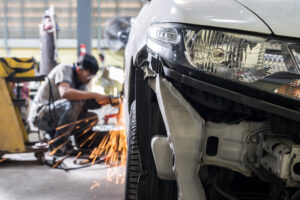Common Problems with Rear Axle Assemblies and How to Identify Them
The rear axle assembly is a vital component of a vehicle’s drivetrain, responsible for transferring power from the engine to the wheels and supporting the weight of the vehicle. It includes the differential, axle shafts, and various other parts that ensure smooth and efficient movement. However, like any mechanical system, the Rear Axle Assembly can experience problems over time, which can lead to decreased performance, safety risks, and costly repairs.
Understanding common issues with the rear axle assembly and knowing how to identify them early can help prevent major failures and extend the life of your vehicle. In this article, we will discuss the most common problems associated with rear axle assemblies and how to recognize the signs before they escalate.
1. Leaking Differential Fluid
One of the most common issues with rear axle assemblies is a leak in the differential fluid. The differential fluid, or gear oil, is essential for lubricating the gears inside the differential, reducing friction and heat. Without adequate lubrication, the components can wear out quickly and lead to serious damage.
Signs of Leaking Differential Fluid:
- Visible Fluid Leaks: If you notice a puddle of thick, dark oil under your vehicle, especially near the rear axle, it’s likely differential fluid. This leak often stems from a worn-out seal or gasket.
- Whining or Howling Noise: A lack of lubrication causes the gears to grind against each other, resulting in a whining or howling noise, especially when accelerating or turning.
- Burning Smell: If the differential fluid is leaking onto hot parts of the vehicle, such as the exhaust system, it may produce a burning odor.
What to Do:
If you suspect a differential fluid leak, inspect the differential cover and seals for damage. It’s crucial to address this issue immediately, as driving with low or no differential fluid can cause severe internal damage.
2. Worn-Out Bearings
The rear axle assembly relies on bearings to support the axle shafts and facilitate smooth rotation. Over time, these bearings can wear out due to lack of lubrication, contamination, or simply from prolonged use. Worn-out bearings can lead to excessive play in the axle, reduced stability, and increased noise.
Signs of Worn-Out Bearings:
- Grinding Noise: A grinding or growling noise that intensifies as you speed up is a common sign of worn-out bearings.
- Vibrations: If you feel vibrations coming from the rear of the vehicle while driving, it could indicate that the bearings are damaged or not properly aligned.
- Uneven Tire Wear: Worn-out bearings can affect the alignment of the rear axle, leading to uneven or accelerated tire wear.
What to Do:
If you detect any of these signs, have your bearings inspected and replaced by a professional. Continuing to drive with faulty bearings can lead to more extensive damage to the axle and drivetrain.
3. Damaged Axle Shafts
Axle shafts are responsible for transmitting torque from the differential to the wheels. These shafts are designed to be durable, but they can bend or break due to impacts, such as hitting a curb or driving over large potholes. A damaged axle shaft can affect the vehicle’s stability and lead to safety concerns.
Signs of a Damaged Axle Shaft:
- Clicking or Clunking Noise: If you hear a clicking or clunking noise while turning or accelerating, it could indicate a bent or cracked axle shaft.
- Difficulty Steering: A damaged axle shaft can interfere with the proper movement of the wheels, making steering more difficult or less responsive.
- Visible Damage: In some cases, you may be able to visually inspect the axle shaft for bends, cracks, or other signs of damage.
What to Do:
If you suspect a damaged axle shaft, it’s important to stop driving and have the vehicle towed to a mechanic. Driving with a damaged axle shaft can lead to complete failure, potentially causing an accident.
4. Faulty Differential Gears
The differential is a key component of the rear axle assembly, allowing the wheels to rotate at different speeds, especially when turning. Over time, the gears inside the differential can wear out or become damaged, often due to inadequate lubrication, aggressive driving, or high mileage.
Signs of Faulty Differential Gears:
- Rattling or Clunking Noise: If the differential gears are worn or damaged, you may hear a rattling or clunking noise coming from the rear of the vehicle, particularly when shifting gears or turning.
- Poor Acceleration: Damaged differential gears can cause power loss, resulting in poor acceleration and reduced overall performance.
- Vehicle Pulling to One Side: If the differential isn’t working properly, the vehicle may pull to one side during acceleration, indicating uneven power distribution to the wheels.
What to Do:
A faulty differential requires immediate attention, as continued driving can worsen the damage. A professional mechanic can diagnose the issue and determine if the gears need adjustment, repair, or replacement.
5. Broken Differential or Axle Housing
The differential and axle housing protect the internal components from debris and provide structural support. However, the housing itself can crack or break due to accidents, off-road driving, or metal fatigue. A broken housing can lead to oil leaks, misalignment, and severe internal damage.
Signs of a Broken Housing:
- Fluid Leaks: Cracks in the housing can cause differential fluid to leak out, leading to lubrication issues.
- Unusual Noises: If the housing is cracked, you may hear unusual noises as the gears and bearings become misaligned.
- Misalignment Issues: A broken housing can cause the entire rear axle assembly to shift, resulting in misaligned wheels and poor handling.
What to Do:
Inspect the housing for visible cracks or damage. If you suspect a broken differential or axle housing, refrain from driving the vehicle and consult a mechanic for a thorough inspection.
How to Prevent Rear Axle Problems
While some wear and tear on the rear axle assembly is inevitable, there are steps you can take to minimize problems:
- Regular Maintenance: Routine inspections and maintenance, including checking and replacing differential fluid, can prevent many common issues.
- Avoid Rough Driving: Sudden impacts, aggressive acceleration, and off-road driving can place extra stress on the axle components.
- Listen for Unusual Noises: Pay attention to any new or unusual sounds from the rear of your vehicle, as they can be early indicators of problems.
Conclusion
The rear axle assembly plays a crucial role in the performance, handling, and safety of your vehicle. Issues with the rear axle can lead to a range of problems, from reduced fuel efficiency to dangerous driving conditions. Understanding the common problems, such as leaking differential fluid, worn-out bearings, damaged axle shafts, faulty differential gears, and broken housings, can help you identify these issues early and address them promptly.
Regular inspections, proper maintenance, and listening for warning signs are key steps in keeping your rear axle assembly in good condition. If you notice any of the symptoms discussed in this article, it’s best to consult a professional mechanic to prevent further damage and costly repairs. By staying proactive, you can ensure a smooth, safe driving experience and prolong the lifespan of your vehicle’s rear axle assembly. You can visit Trendinghub24 to get more information.














Post Comment